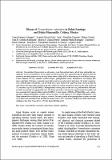Por favor, use este identificador para citar o enlazar a este item:
http://hdl.handle.net/10261/52977COMPARTIR / EXPORTAR:
 SHARE
BASE SHARE
BASE
|
|
| Visualizar otros formatos: MARC | Dublin Core | RDF | ORE | MODS | METS | DIDL | DATACITE | |

| Título: | Bloom of Gymnodinium catenatum in Bahía Santiago and Bahía Manzanillo, Colima, Mexico |
Autor: | Quijano-Scheggia, Sonia CSIC; Olivos-Ortiz, Aramis; Bustillos-Guzmán, José J.; Garcés, Esther CSIC ORCID CVN ; Gaviño-Rodríguez, Juan; Galicia-Pérez, Marco A.; Patiño-Barragan, Manuel; Band-Schmidt, Christine J.; Hernández-Sandoval, Francisco J.; López-Cortés, David J. | Palabras clave: | Gymnodinium catenatum Algal blooms Toxicity Upwelling |
Fecha de publicación: | mar-2012 | Editor: | Universidad de Costa Rica | Citación: | Revista de Biología Tropical 60 (1): 173-186 (2012) | Resumen: | [EN]Gymnodinium bloom events are of concern, since they produce toxins, which have unfavorable consequences to marine ecosystems, human health and the economy. This report describes the physico-chemical
conditions that were present during the algal bloom event on May 2010 in Bahía Manzanillo and Bahía Santiago, Colima, Mexico. For this, seawater nutrient analysis, phytoplankton counts, identification, and toxicity tests were undertaken. Nutrients in seawater were determined using colorimetric techniques, the higher concentrations (8.88μM DIN, 0.78μM PO4 and 24.34μM SiO2) were related with upwelling waters that promoted the algal bloom that began after registering the year lowest sea-surface temperature, favoring the rapid growth of G. catenatum (up to 1.02 x107cells/L). Phytoplankton counting was carried out using sedimentation chambers and cells enumerated on appropriated area. The bloom persisted in the bays for approximately two weeks and was associated with toxicity (determined with (PLC) in local oysters (1525.8μg STXeq/100g), and in phytoplankton (10.9pg STXeq/cells) samples. Strong variations in cell toxicity (1.4 to 10.9pg STXeq/cells), most likely reflected the availability of inorganic nutrients. The toxin profile of the phytoplankton samples consisted of 11 toxins and resembled those recorded for several strains of G. catenatum isolated from other coastal areas of Mexico. [ES]La proliferación de Gymnodinium son motivo de preocupación, debido a que en algunas circunstancias producen toxinas, que tienen consecuencias desfavorables para los ecosistemas marinos, la salud humana y la economía. Este trabajo describe las condiciones fisicoquímicas presentes durante una proliferación algal detectado en mayo de 2010 en la Bahía de Santiago y Bahía Manzanillo (Colima, México). La proliferación algal inició poco tiempo después de registrarse las temperaturas oceánicas superficiales más bajas del año, las cuales permitieron un aumento de las concentraciones de nutrientes (8.88μM DIN, 0.78μM PO4 and 24.34μM SiO2) que favorecieron el desarrollo de G. catenatum (hasta 1.02 x107cel/L). Esta proliferación se detectó en las bahías durante dos semanas y fue relacionada con toxicidad en ostiones de la localidad (1525.8μg STXeq/100g) y en muestras de fitoplancton (10.9pg STXeq/cel). Fuertes variaciones en la toxicidad de G. catenatum (1.4 a 10.9pg STXeq/cel) pudieron reflejar la disponibilidad de nutrientes inorgánicos. El perfil de toxinas de las muestras del fitoplancton consistieron en 11 toxinas semejantes a las de varias cepas de G. catenatum aisladas de otras áreas de las costas de México. |
Descripción: | 14 pages, 6 figures, 3 tables | Versión del editor: | http://www.ots.ac.cr/tropiweb/intpages/fullartsspa.html | URI: | http://hdl.handle.net/10261/52977 | ISSN: | 0034-7744 | E-ISSN: | 2215-2075 |
| Aparece en las colecciones: | (ICM) Artículos |
Ficheros en este ítem:
| Fichero | Descripción | Tamaño | Formato | |
|---|---|---|---|---|
| Quijano_et_al_2012.pdf | 757,17 kB | Adobe PDF |  Visualizar/Abrir |
CORE Recommender
Page view(s)
344
checked on 23-abr-2024
Download(s)
177
checked on 23-abr-2024
Google ScholarTM
Check
NOTA: Los ítems de Digital.CSIC están protegidos por copyright, con todos los derechos reservados, a menos que se indique lo contrario.
